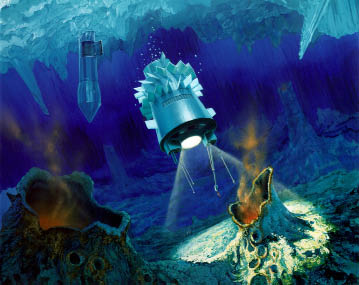| Exploring the Deep Sea
By TANG YUANKAI
JAMES Cameron is great, says Wang Pinxian, a professor at Tongji University’s School of Ocean and Earth Science and an academician of the Chinese Academy of Sciences.
Wang’s not talking about films like Avatar and Titanic, directed by Cameron. Rather, he’s interested in the Canada native’s record-breaking dive to the bottom of Challenger Deep, the deepest part of the Mariana Trench, and of all earth’s oceans. When Cameron descended 10,898 meters below sea level on March 26, 2012, he became the first person to complete the dive solo.
Wang Pinxian may not be a film director, but he’s certainly at the forefront of Chinese oceanography. His chief project is perfecting a Chinese design for a one-man submersible capable of reaching great depths. Called Jiaolong – a dragon in Chinese mythology – Wang’s craft is used for marine scientific research.
From a practical point of view, Wang is keen to point out the links between exploration of the sea, the rich resource deposits that lie beneath the sea floor and the future of China’s economic and societal development. Marine research reveals our planet’s history, and gives clues to its future, he says. “Dive down several thousand meters and the sea’s secrets reveal themselves. Besides, we also get to learn a lot more about the workings of the planet we call home.”
 |
|
After centuries of exploration by mankind, the sea remains mysterious and unfathomable. |
The highest mountain in the world is Mount Chomolangma, at 8,844.48 meters. The Mariana Trench, however, bottoms out at a breathtaking 11,034 meters. If Mount Chomolangma were to rise from that depth, you would need to place 7 Eiffel Towers on top of each from the mountain’s peak just to reach the water’s surface.
“The sea is so mysterious and unfathomable!” says Wang, excitedly. He’s now 76 years old and has been working in the field of oceanography for decades.
Last year, Wang was awarded a RMB 150 million grant by China’s National Natural Science Foundation to lead an eight-year study into the geology and biology of the South China Sea, the largest-ever such project.
“The South China Sea is a Mecca for oceanographers and climatologists,” Wang says, adding it’s been his dream to do research in the sea for many years.
Further down the line, Wang hopes the Ocean Drilling Program (ODP) will come for a second time to the South China Sea in 2014. Wang wants to see China take a lead in ODP research and for China’s own drilling designs to be employed.
The U.S. initiated the ODP, which was co-sponsored by more than 10 countries, in 1985. China joined in 1998. Early on, Wang and several other Chinese scientists submitted a proposal to the program on East Asian monsoons in the South China Sea and their influence on global climate. This proposal was well received in the international scientific community and gave birth to ODP Leg 184 in the South China Sea in the spring of 1999. Wang was one of two lead scientists on the project, which marked the first time China had done drilling research in the sea. It was a landmark event, both for China and for marine science in general.
The South China Sea, extending far south from China’s mainland, is technically a marginal sea of the West Pacific. Sediment accumulated in the sea due to the erosion of surrounding mountains makes it possible to construct detailed records of the regional climate over the past 45 million years.
| 